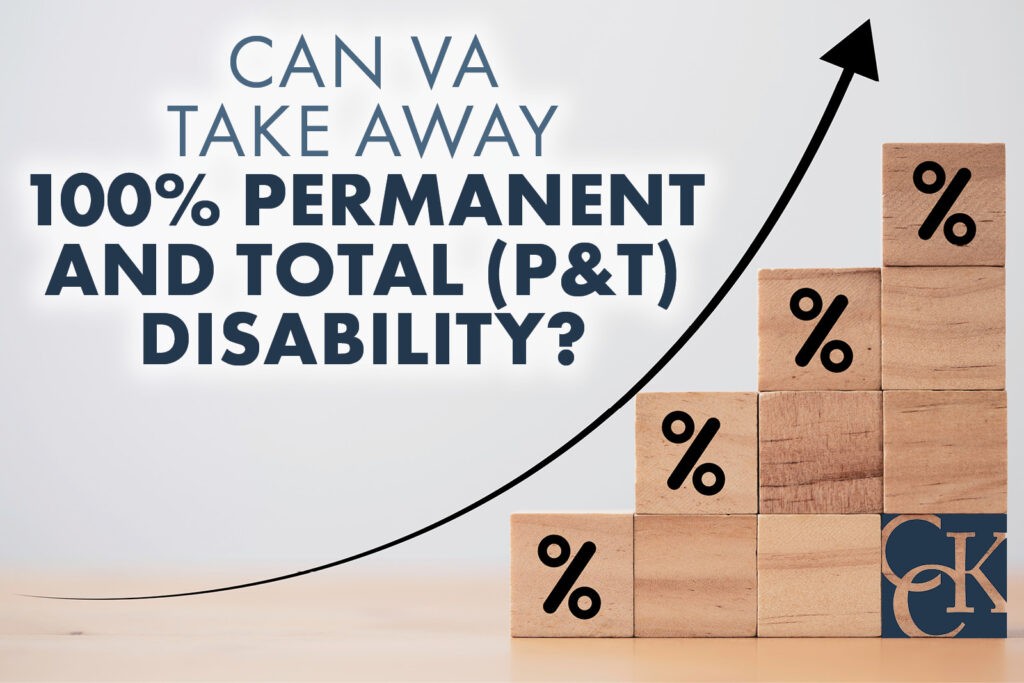Can VA Take Away 100% Permanent and Total (P&T) Disability?

CCK Law: Our Vital Role in Veterans Law
Brief Overview of 100% Permanent and Total (P&T) Disability
Permanent and Total disability, or P&T, is Department of Veterans Affairs (VA) disability benefit granted to veterans whose service-connected conditions are considered total (rated 100 percent disabling) and permanent (zero or close to zero chance of improvement).
While “permanent and total” is often used as a single phrase, veterans can have a total disability that is temporary, or a permanent disability rated less than 100 percent.
VA deems a disability permanent when it is reasonably certain, based on medical evidence, that the level of impairment will continue for the remainder of the veteran’s life. It is important to note that VA is allowed to take a veteran’s age into account when determining permanence.
Can VA Take Away Permanent and Total (P&T) Disability?
In most instances, VA assumes that veterans with P&T disability ratings will have to live with severely debilitating service-connected conditions, or their residuals, for the rest of their lives.
Therefore, if VA determines your condition is permanent and total, you are protected from the possibility of a reduction. Essentially, you will continue to receive disability compensation at 100 percent for the remainder of your life.
There are several rare circumstances in which VA might reevaluate or reduce a veteran’s 100% P&T disability status. For example:
- VA discovers that the original 100% P&T rating was based on fraud.
- A VA Quality Review finds a Clear and Unmistakable Error in the original rating.
- The veteran opens a new claim to include Special Monthly Compensation. If VA sees that the veteran’s impairments have improved or might improve, VA may reduce the veteran’s initial rating.
- The veteran opens a new claim for a Specially Adapted Housing or Special Housing Adaptation grant. These claims require a Compensation and Pension (C&P) exam. If the C&P examiner determines a veteran’s conditions have improved or might improve, VA may reduce the original rating.

How to Tell If Your VA Disability Rating Is Permanent
Veterans can look at their VA rating decision letter to determine if their rating is considered permanent by VA.
On some Rating Decisions, VA will check a Permanent and Total box. On others, there may be a language like “Eligibility to dependents Chapter 35 DEA / CHAMPVA are established” or “No future exams are scheduled” – both of which indicate permanence. The exact language may vary between different VA regional offices.
If, however, the letter states that future exams are scheduled, then your total disability rating is not considered permanent by VA.
Can I Request a Permanent Disability Rating?
Yes, veterans can request a permanent rating. If you have a 100 percent total disability rating and you believe that it is unlikely to improve at any point in the future, you can request a permanent rating.
You can write a letter to your local VA Regional Office requesting a permanent rating. With your letter, you should include medical evidence (treatment records) showing that your medical condition will not likely improve in the future.

Additional Benefits for P&T Veterans
A P&T disability rating entitles veterans to other benefits. These include the following:
- CHAMPVA (VA healthcare for your dependents)
- Dependents’ Educational Assistance program (Chapter 35 DEA)
- Dependency and Indemnity Compensation (DIC), often referred to as “death benefits”
- Certain state-level benefits for veterans
Note: Other factors may also be considered in determining eligibility for these benefits.
Our Veterans’ Advocates May Be Able to Help You Get P&T Status
Dealing with VA can be incredibly difficult. The experienced, accredited veterans’ attorneys at Chisholm Chisholm & Kilpatrick may be able to assist you with obtaining a P&T disability rating. Our team has more than 30 years of collective experience helping veterans win the benefits they deserve. Call CCK today at (800) 544-9144 to schedule a free case evaluation.
About the Author
Share this Post
